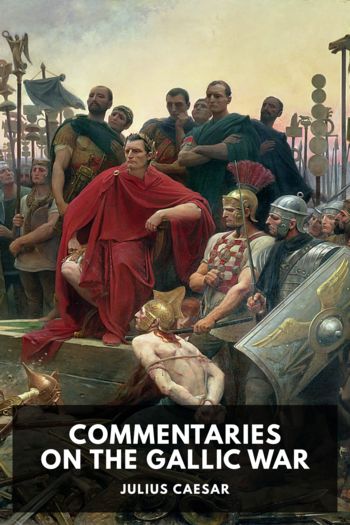Fateful Lightning: A New History of the Civil War & Reconstruction by Allen Guelzo (icecream ebook reader txt) 📗

- Author: Allen Guelzo
Book online «Fateful Lightning: A New History of the Civil War & Reconstruction by Allen Guelzo (icecream ebook reader txt) 📗». Author Allen Guelzo
Grant’s operations in Virginia were only one part of his overall strategic plan for 1864, and he depended heavily on the successes won in Georgia by William Tecumseh Sherman. Lloyd Lewis’ Sherman: Fighting Prophet (New York: Harcourt, Brace, 1932) is a rare masterpiece of literary craft and remains an outstanding Sherman biography, although it is marred in discussing Sherman’s racial prejudices by Lewis’ own disparaging comments on black soldiers. Charles Royster’s The Destructive War: William Tecumseh Sherman, Stonewall Jackson, and the Americans (New York: Knopf, 1991) is a peculiar and (to quote one reviewer) “paradoxical” essay on Sherman and the military theme of destruction in war most often associated with Sherman. But it has forced biographers of Sherman to deal with the problem of endemic violence in American culture, and especially in Michael Fellman, Citizen Sherman: A Life of William Tecumseh Sherman (New York: Random House, 1997) and Stanley P. Hirshson, The White Tecumseh: A Biography of General William T. Sherman (New York: J. Wiley, 1997). Johnston’s decision to settle into a siege around Atlanta was his undoing, and the siege itself has been marvelously spoken for in Albert Castel’s Decision in the West: The Atlanta Campaign of 1864 (Lawrence: University Press of Kansas, 1992), Richard M. McMurry, Atlanta 1864: Last Chance for the Confederacy (Lincoln: University of Nebraska Press, 2001), Marc Wortman’s The Bonfire: The Siege and Burning of Atlanta (New York: Public Affairs, 2009), Russell S. Bonds’ War Like the Thunderbolt: The Battle and Burning of Atlanta (Yardley, PA: Westholme, 2009), and Gary Ecelbarger’s The Day Dixie Died: The Battle of Atlanta (New York: St. Martin’s Press, 2010). Franklin was a particular exercise in tactical folly, and has attracted the notice of Wiley Sword in Embrace an Angry Wind: The Confederacy’s Last Hurrah: Spring Hill, Franklin and Nashville (New York: Harper Collins, 1992) and James McDonough and Thomas Connelly in Five Tragic Hours: The Battle of Franklin (Knoxville: University of Tennessee Press, 1983).
Lincoln’s difficulties with the Radicals of his own party have been the subject of ongoing debate since Lincoln’s death. On the one hand, Hans L. Trefousse’s The Radical Republicans: Lincoln’s Vanguard for Racial Justice (New York: Knopf, 1968) makes a passionate plea for interpreting the Radicals as Lincoln’s secret agents for promoting policies Lincoln could not afford to openly endorse. On the other hand, T. Harry Williams’s Lincoln and the Radicals (Madison: University of Wisconsin Press, 1941) just as passionately argues that Lincoln was a moderate who struggled in vain to keep the Radicals from turning the war into a political vendetta against the South. Individual biographies of the Radicals are not hard to come by, beginning with Hans L. Trefousse’s Thaddeus Stevens: Nineteenth-Century Egalitarian (Chapel Hill: University of North Carolina Press, 1997), David Donald’s Charles Sumner and the Rights of Man (New York: Knopf, 1970), and Richard Sewall’s John P. Hale and the Politics of Abolition (Cambridge, MA: Harvard University Press, 1965). A clearer view of just who the Radicals were as a group emerges from Allan G. Bogue’s The Earnest Men: Republicans of the Civil War Senate (Ithaca, NY: Cornell University Press, 1981), which used mathematical analyses of roll call votes to identify the core of Radical leadership in the Senate.
Some of the most controversial legislation written by the Congressional Radicals concerned conscription. James Geary’s We Need Men: The Union Draft in the Civil War (DeKalb: Northern Illinois University Press, 1991) is a clear, precise, and highly illuminating analysis of conscription in the North, and carefully distinguishes the various drafts and draft calls, who was most likely to be conscripted, and how many draftees actually wound up in the Federal armies. The most notorious response to the draft in the North was the New York City draft riot. Iver C. Bernstein’s The New York City Draft Riots: Their Significance for American Society and Politics in the Age of the Civil War (New York: Oxford University Press, 1990) skillfully sets the riots against the background of New York labor and racial unrest during the war, while Adrian Cook’s The Armies of the Streets: The New York City Draft Riots of 1863 (Lexington: University





Comments (0)